AgentOps helps developers see inside their AI agents by logging every prompt, action, and cost. This review explains how it works, its features, setup, and why it’s becoming the go-to debugging tool for AI developers.
Printify vs Shopify: Why Printify is the Better Choice for Your Business
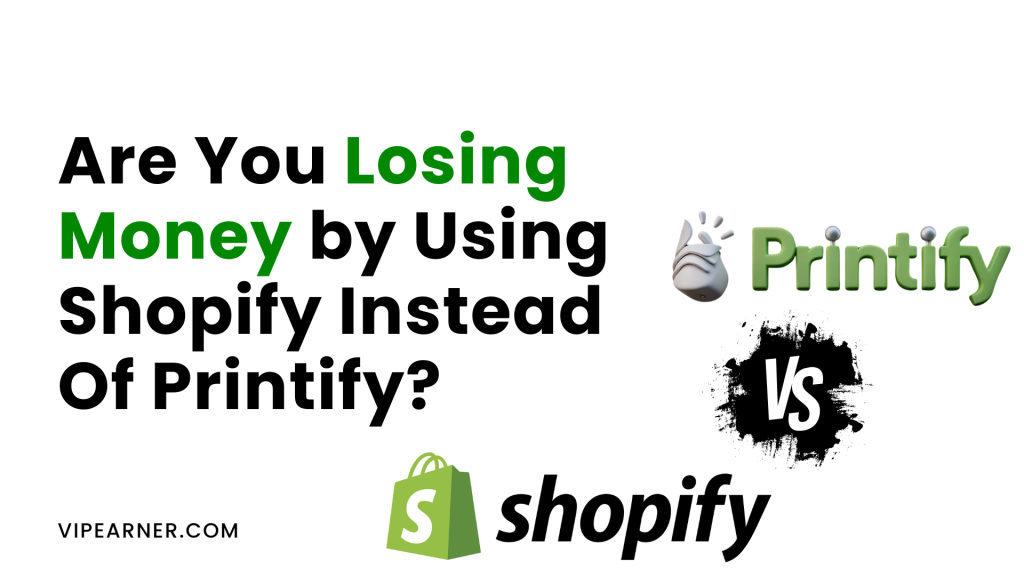
Print-on-demand (POD) has emerged as a popular business model for entrepreneurs seeking low-risk, creative ventures. When comparing Printify and Shopify for POD businesses, Printify stands out as the superior choice. Here's how:
1. What is Printify?
Printify operates as a print-on-demand platform that bridges the gap between product design and customer delivery. The service integrates seamlessly with online stores and marketplaces, enabling entrepreneurs to upload custom designs, which Printify’s global network of print partners then produces and ships directly to customers.
Unlike traditional e-commerce models, Printify requires no upfront inventory investment, as items are manufactured only after orders are placed. This model eliminates storage costs and minimizes financial risk.
The platform’s automated fulfillment process begins when a customer places an order through a connected sales channel, such as an online store or marketplace.

Printify immediately routes the order to the nearest print provider, handles production, and dispatches the product with white-label packaging. This end-to-end automation ensures merchants can focus solely on branding and customer acquisition without logistical burdens 1.
Key advantages of Printify include its free pricing tier, which allows users to connect up to five stores and access unlimited product designs, and its extensive catalog of over 800 customizable products—from apparel to home decor. Additionally, Printify’s real-time mockup generator and integration with platforms like Etsy and Shopify streamline the product listing process, making it accessible even for beginners 3.
2. What is Shopify?
Shopify functions as a full-service e-commerce platform, providing tools to build, manage, and scale online stores. Users can create customized storefronts, process payments, and track inventory across multiple sales channels.
While Shopify supports diverse business models—including physical goods, digital products, and subscriptions—it lacks native print-on-demand capabilities. Merchants must either handle production internally or integrate third-party POD services like Printify, adding layers of complexity.
Shopify’s strengths lie in its customization options and scalability. The platform offers hundreds of responsive themes, advanced SEO tools, and a vast app marketplace with over 8,000 integrations.
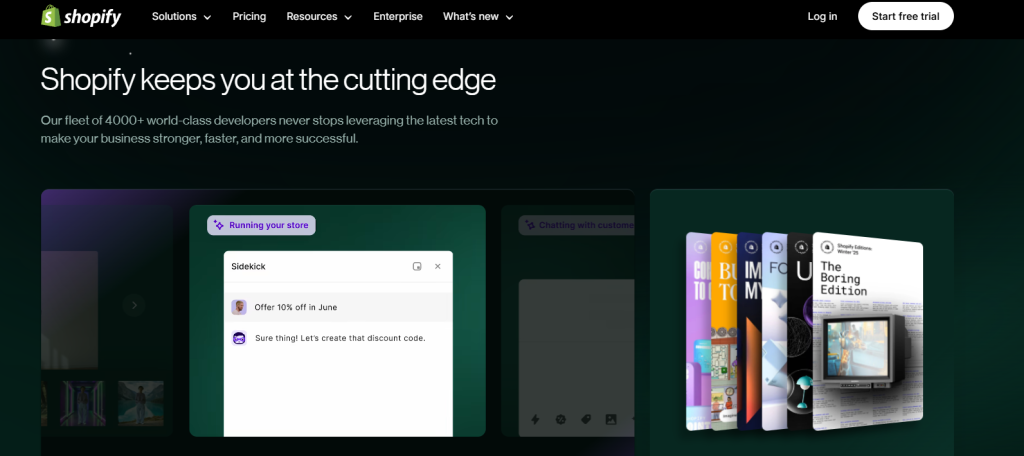
However, these features come at a cost: subscription plans start at $39/month, excluding transaction fees and app expenses.
For businesses requiring intricate store designs or multi-channel sales strategies, Shopify provides unparalleled flexibility. Yet, its learning curve and operational demands—such as inventory management and order fulfillment—can overwhelm solo entrepreneurs or small teams.
3. Key Differences Between Printify and Shopify
The divergence between Printify and Shopify becomes evident when examining their core functionalities:
| Aspect | Printify | Shopify |
|---|---|---|
| Business Model | Print-on-Demand (POD) | eCommerce Website Builder |
| Cost Structure | Free plan available; pay per product sold | Monthly subscriptions starting at $39/month |
| Fulfillment | Automated via global print providers | Manual or third-party app-dependent |
| Inventory Needs | Zero inventory required | Inventory management essential |
| Ease of Use | Beginner-friendly with minimal setup | Steeper learning curve and technical demands |
Printify’s POD model removes the need for inventory storage and upfront capital, contrasting sharply with Shopify’s requirement for merchants to source, stock, and ship products independently. While Shopify excels in store customization, its costs and operational demands make it less accessible for entrepreneurs prioritizing simplicity and low overhead 1.
a) Lower Financial Barriers to Entry
Printify’s free tier allows entrepreneurs to launch POD businesses without monthly fees, paying only when products sell. In contrast, Shopify’s cheapest plan costs $39/month, plus transaction fees up to 2.9% + $0.30 per sale. For startups testing product ideas or operating on slim margins, Printify’s pay-as-you-go model significantly reduces financial risk. Additionally, Printify users avoid costs associated with unsold inventory, a common pitfall for Shopify merchants managing physical stock 6.
b) Automated Fulfillment and Logistics
Printify’s integration with 90+ global print providers ensures orders are produced and shipped within 2–7 business days, with automatic tracking updates sent to customers. Shopify merchants, however, must either fulfill orders manually—a time-consuming process—or pay for third-party fulfillment apps. For solopreneurs, this automation translates to saved hours and reduced error rates, enabling scalability without hiring staff.
c) Focus on Creativity Over Operations
By handling production and logistics, Printify allows entrepreneurs to concentrate on design innovation and marketing. Shopify users, conversely, juggle website maintenance, inventory audits, and customer service. A POD business using Printify can launch 50+ product designs across multiple categories in days, whereas a Shopify store selling physical goods requires weeks to source suppliers and establish fulfillment workflows 4.
d) Diverse Product Catalog
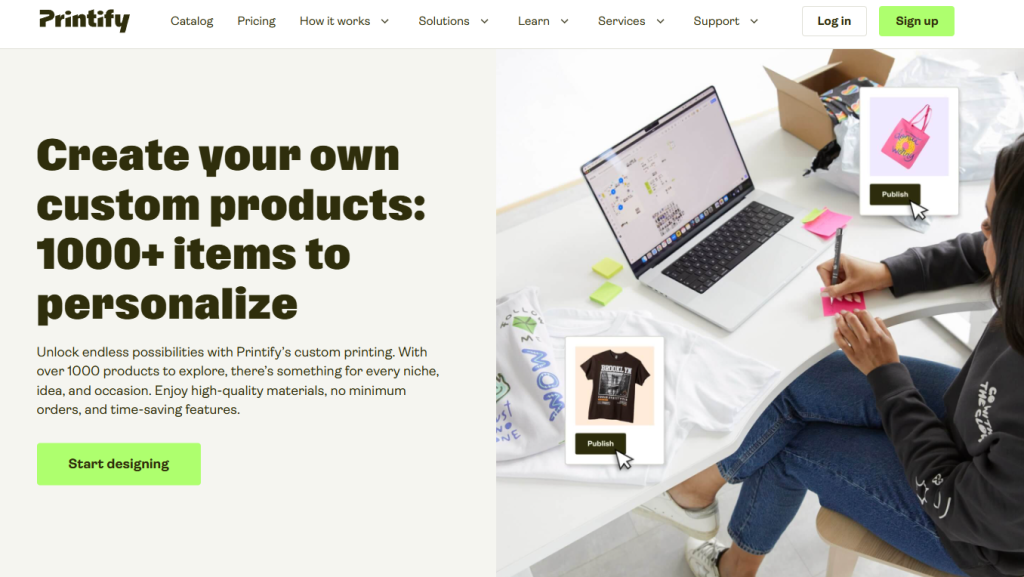
Printify offers 1000+ customizable items, including apparel, accessories, and home goods, all available through a single dashboard. Shopify provides no products; merchants must source inventory independently, often requiring contracts with multiple suppliers. This diversity allows Printify users to rapidly test trends—like seasonal apparel or niche accessories—without supplier negotiations or minimum order quantities 3.
e) Multi-Platform Integration
Printify connects seamlessly with Etsy, eBay, WooCommerce, and Shopify, enabling simultaneous sales across marketplaces. Shopify, while robust, functions primarily as a standalone storefront. Merchants using both platforms benefit from Shopify’s customization paired with Printify’s POD efficiency, but those prioritizing marketplace reach may find Printify’s native integrations more versatile 5.
5. When to Choose Shopify
Shopify becomes advantageous in scenarios requiring full brand control and diverse product offerings. Businesses selling handmade goods, subscription boxes, or in-house manufactured items benefit from Shopify’s inventory tools and branded checkout experiences. Additionally, enterprises aiming to scale across social media, in-person pop-ups, and wholesale channels will find Shopify’s multi-channel management indispensable 1.
6. Printify's Competitive Edge in the POD Market
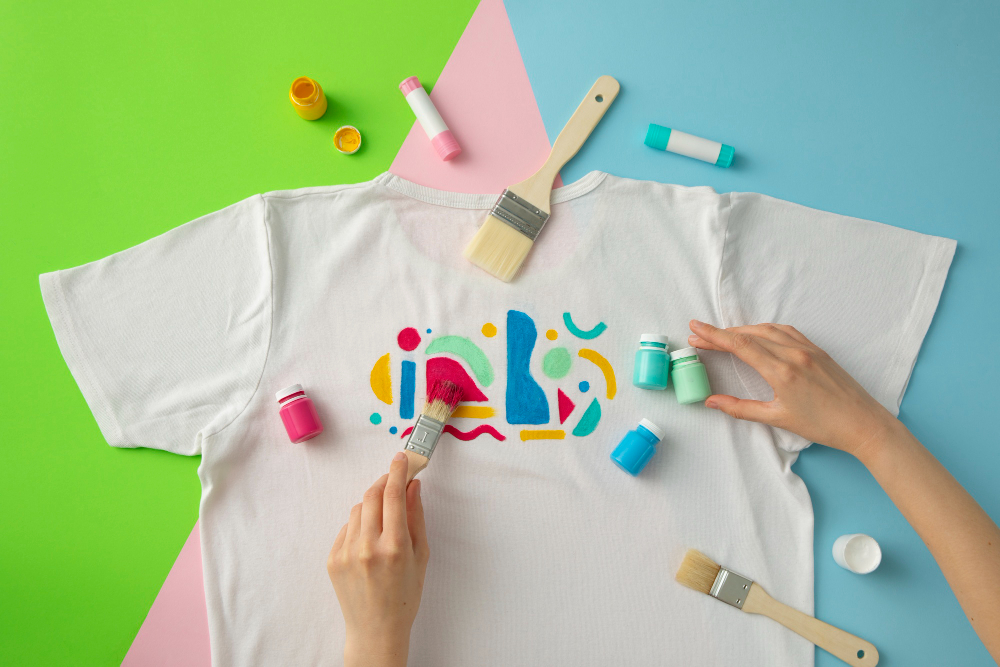
Printify stands out in the print-on-demand industry due to its unique advantages that differentiate it from competitors and traditional e-commerce platforms like Shopify. One of the most significant strengths of Printify is its extensive and diverse product catalog. With over 800 customizable products available, entrepreneurs have an unprecedented opportunity to diversify their offerings without the complexities of managing multiple suppliers.
This vast product range includes everything from apparel like t-shirts and hoodies to accessories such as bags and phone cases, and even home decor items like pillows and wall art. This flexibility allows businesses to easily test new product lines, respond to seasonal trends, and cater to niche markets without any upfront inventory costs.
Printify's global network of over 90 print providers is another significant advantage. This network ensures faster production times, as orders are routed to the nearest provider, reducing production delays. Additionally, shipping costs are lower due to proximity to customers, and there is increased reliability as multiple providers ensure business continuity even if one supplier faces issues.
7. Advanced Features of Printify
Printify offers a suite of advanced features designed to streamline the POD business process and enhance merchant success. One of the most powerful tools is the real-time mockup generator.
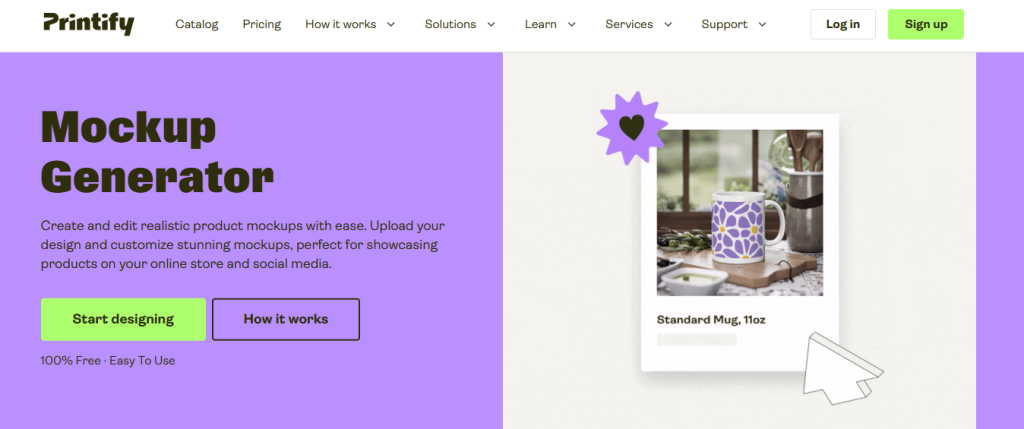
This feature allows users to visualize their designs on products instantly, saving time and effort in creating and listing new products. With the mockup generator, entrepreneurs can see exactly how designs will look on different products and colors, ensuring accuracy and reducing the need for complex design software.
The built-in pricing calculator is another invaluable tool for Printify users. It helps set competitive prices while ensuring profitability by providing real-time cost updates and profit margin calculations. This tool takes the guesswork out of pricing, allowing even novice entrepreneurs to make informed decisions about their product offerings.
8. Success Stories and Case Studies
Printify has empowered numerous entrepreneurs to achieve remarkable success in the print-on-demand industry. Here are a few inspiring stories that highlight the potential of using Printify for your POD business:
1. Byron Allen: From Struggling Entrepreneur to $350k/year Etsy Success

Byron Allen started his t-shirt business in 2014 but faced setbacks until switching to Printify. By leveraging Printify’s global print network and automated fulfillment, he scaled his Etsy store to $350,000 in annual revenue while working full-time at Home Depot.
Key Takeaway: Printify’s flexibility allowed Byron to balance his day job while growing his side hustle into a thriving business.
Source: Printify Blog: Byron Allen’s Story
2. Brett & Daisy: $200k/Month in Under a Year

This Australian couple combined Brett’s marketing expertise with Daisy’s hustle to build a print-on-demand empire. Using Printify’s integrations with Etsy and Shopify, they achieved $200,000 in monthly revenue within 12 months.
Key Takeaway: Their success highlights Printify’s scalability for entrepreneurs willing to experiment with niches and marketing strategies.
Source: Printify Blog: Brett & Daisy’s $200k Journey
3. Mike Pasley: $700k in First Year with Niche Designs
Graphic designer Mike Pasley turned his passion into profit by creating quirky, meme-inspired apparel. Using Printify’s mockup generator and global fulfillment, he generated $700,000 in revenue in his first year.
Key Takeaway: Printify’s design tools and quality control enabled Mike to focus on creativity while outsourcing production.
Source: Printify Blog: Mike Pasley’s $700k Strategy
4. Gina Van De Voorde: From Burnout to $100k with POD

A stay-at-home mom turned Etsy-POD expert, Gina used Printify to escape her 9-to-5 job. She now earns $100k/year selling minimalist text-based designs, proving you don’t need design skills to succeed.
Key Takeaway: Printify’s Etsy integration simplified listing and fulfillment, letting Gina focus on trend research.
Source: Printify Blog: Gina’s $100k Blueprint
5. Printify Express Delivery: Fast Shipping Boosts Sales

Vietnamese sellers Linh and Hoa increased customer satisfaction by 40% using Printify’s Express Delivery. Orders now ship in 2–3 days (vs. 7–14 days previously), reducing cart abandonment.
Key Takeaway: Faster fulfillment = happier customers and repeat sales.
Source: Printify Express Delivery Case Study
Printify vs. Shopify: Integration Benefits
While Printify excels in the print-on-demand space, Shopify offers robust e-commerce capabilities that can complement Printify's strengths. Integrating Printify with Shopify allows businesses to leverage the best of both worlds.
Shopify provides advanced store customization options, multi-channel sales capabilities, and powerful inventory management tools, which are ideal for businesses that also sell non-POD products or require full brand control.
On the other hand, Printify handles the POD aspect seamlessly, automating production and logistics, which can be integrated into a Shopify store. This combination allows entrepreneurs to focus on branding and marketing while benefiting from Shopify's scalability and customization options.
9. Environmental Impact of POD
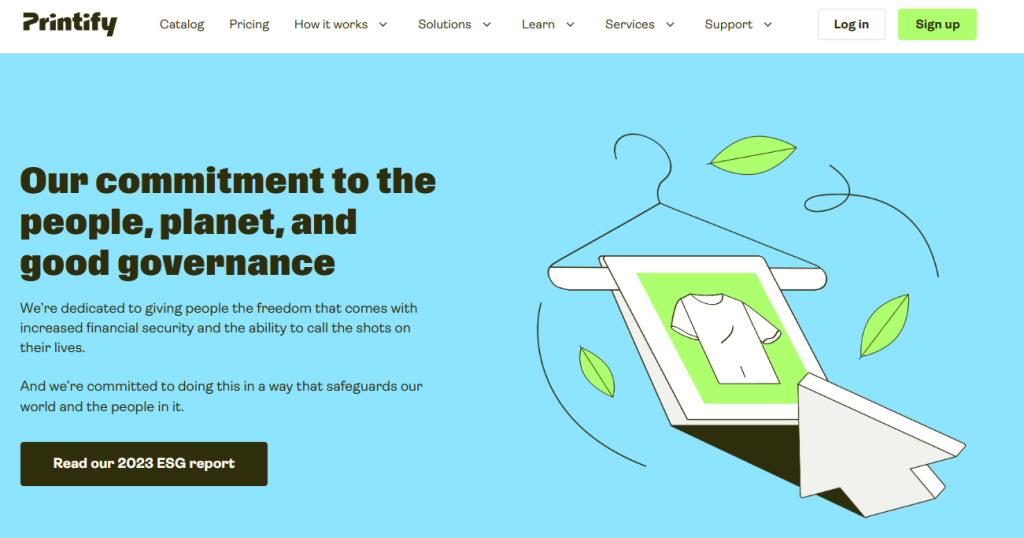
The print-on-demand model, as facilitated by platforms like Printify, has a significant environmental benefit compared to traditional manufacturing and inventory models. By producing items only after they are ordered, POD reduces waste and minimizes the carbon footprint associated with unsold inventory. This approach aligns with growing consumer demand for sustainable products and practices, making it an attractive option for eco-conscious entrepreneurs.
10. Tips for Success with Printify
To achieve success with Printify, entrepreneurs should focus on several key strategies:
- Niche Selection: Identify trends and areas with high demand but relatively low competition. Use tools like Google Trends or social media to gauge interest in specific designs or products.
- Quality Designs: Invest in high-quality designs that are visually appealing and relevant to your target audience. Consider hiring a designer if you lack design skills yourself.
- Social Media Marketing: Leverage social media platforms like Instagram and TikTok to showcase your POD products. Use influencer partnerships and sponsored ads to reach a wider audience.
- Product Line Optimization: Monitor sales data and customer feedback to identify which products are performing well and which need improvement. This iterative approach will help you refine your product line and maximize profitability.
11. Conclusion: Printify Empowers Agile Entrepreneurship
For entrepreneurs targeting the print-on-demand market, Printify delivers unmatched efficiency and cost-effectiveness. Its elimination of inventory costs, coupled with automated fulfillment, positions it as the optimal choice for minimizing risk while maximizing creative output.
While Shopify remains a powerful tool for traditional e-commerce, Printify’s specialized focus on POD reduces entry barriers, allowing businesses to allocate resources toward growth and innovation. As global e-commerce continues to expand, platforms like Printify democratize access to entrepreneurial success, proving that strategic tool selection can redefine competitive advantage.
Launch your POD venture today using Printify’s free plan to test designs, explore niches, and scale effortlessly—no inventory or upfront fees required.

